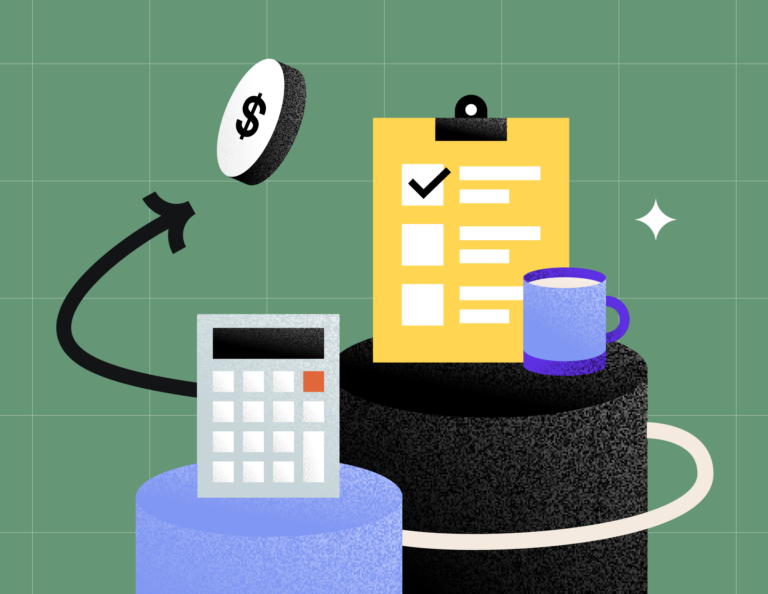Small business financial management is key to longevity, but it isn’t always intuitive. Here’s your starter guide to understand what you should be tracking, which reports to use, and how to keep your finances healthy.

Financial management is essential for any business, but particularly so for independents. The 33.2 million SMEs across the US don’t usually have as much access to capital as bigger businesses, which makes it increasingly difficult to recover from financial downturns.
Understanding how money flows through your business will help you make more informed decisions. You can stay in the green throughout all types of situations, stay on top of your taxes, and be more strategic about your business growth.
Managing your finances includes everything from expenses to profit, credit, and debt. Use our guide to understand what’s important for independent business owners.
Table of Contents
- Managing your cash flow
- Tracking expenses
- Tracking profit and loss
- Common financial reports for small business
- Creating a strategy for business credit
- Additional tips for healthy business finances
- Improve small business financial management with a clientflow platform
Managing your cash flow
A key component of small business financial management is understanding and managing your cash flow. This means knowing when money is coming in and when it needs to go out for expenses like taxes or payroll. It also requires tracking client payments. This way, you can anticipate any gaps in your income stream before they occur and take steps to fill them if necessary.
For example, being mindful of how long it takes clients to pay invoices can help you plan accordingly. At the same time, knowing what expenses are fixed versus variable allows you to make informed decisions about what’s right for your business. This helps to lessen the strain on your finances or resources, such as taking on additional clients or hiring more staff members.
Managing your cash flow requires you to predict future earnings and expenses. The basics are pretty straightforward:
- Track past income, expenditures, and profits for at least six months prior so you can better forecast what your business will need over the following months or years.
- Look into trends related to seasonal sales or changes due to market conditions that may affect your spending on materials, staff wages, and other expenses. This data will help you develop accurate estimates of future income needs based on historical performance as well as any expected changes.
- Create a budget by calculating all expected income and expenses over the next few months or up to one year, then adjust as needed when changes arise.

Pro Tip: Consider your spending and expense categories carefully. This will help you identify areas where you can cut back on spending or redirect funds into investments that could lead to greater profits. Target only realistic goals, otherwise, you could be setting yourself up for failure.
Once complete, review your budget regularly so it stays consistently relevant!
RELATED POST
Tracking expenses
Being able to track expenses is easier said than done for some, especially as many small to mid-sized entrepreneurs juggle numerous responsibilities. But you can’t properly manage cash flow if you don’t track your expenses and understand how your money is flowing.
Here are some tips for tracking business expenses:
- Record your cash flow in and out: Keeping accurate records of all the money coming in and out of your business allows you to better manage cash flow when income may be variable or uncertain. This includes tracking sales income and operational costs, like utilities, rent, wages, and more.
- Categorize expenditures: Separating different types of expenditures will clarify what areas need more attention or fewer resources allocated, like marketing vs payroll costs over time. This could save money in certain areas while generating more profit from others depending on current conditions within the industry/market sector(s).
- Keep track of receipts: Keep receipts from any purchase made by your company (which should always include date/time stamps) so they can be used later if needed. This is usually either when filing taxes at year-end or double-checking transactions with suppliers. This also applies to clients who may have been issued refunds due to a service policy or something else.
These simple steps will ensure that all expenditures incurred by your small business remain visible throughout its profitability journey. These steps help to keep track of spending patterns over time, enough of which will show you more cash flow optimization opportunities.
Tracking profit and loss
Now that you’ve got the basics of tracking expenses, it’s time to move on to tracking profit and loss.
Tracking profit and loss indicates that you’re watching the amount of money you make from sales or services minus all expenses related to that income, such as overhead costs and taxes. This will give you an accurate picture of your overall profitability for any given period. It also helps you visualize where your money is coming from and going.
Tracking your profit and loss will give you greater control over your cash flow by providing insight into your business’s financial health over time.
A key document for this effort is the profit and loss statement (P&L). This statement (also called an income statement/report) summarizes incurred business revenues, expenses, and costs over a specified period. It shows whether your business made or lost money during that period by comparing how much you generated in sales and how much you spent to bring in those sales.
Creating a P&L statement can help you identify areas where you may need to adjust operations or pricing strategies to maximize profitability and minimize losses. Additionally, accurate data from your P&L will make it much easier to prepare business taxes.
Common financial reports for small businesses
Aside from the P&L or income statement, there are additional common financial reports that are either legally required or useful to have for small businesses. These reports offer insights similar to how a P&L statement would, only for different aspects of your business.
Accounts receivable (AR) and accounts payable (AP)
Accounts receivable (AR) include money that clients still owe you (unpaid invoices). Accounts payable (AP) is money that you owe, whether that includes expenses, loans, or debts. Creating AR and AP reports can provide a better gauge of expected income and expenses for your business. This ratio may vary from industry to industry, so it is important to compare results with past years.
You can use payment processing software such as HoneyBook to securely send invoices and receive payments in the same system. When the ratio of accounts receivable vs. accounts payable is low, it may be time to adjust your payment schedules or look into your late payment policies.
Expense report
An expense report is an organized way to document and track expenses. These reports can identify opportunities for cost savings, areas of potential overspending, or other discrepancies in your budget or income statements. It’s important to stay consistent when you’re categorizing expenses to accurately track information over time and quickly identify trends.
RELATED POST
Balance sheet
A balance sheet is a quick overview of your business’s financial standing, including liabilities, assets, and equities. Liabilities are everything that your business owes, like loans or salaries. Assets, on the other hand, are what you own, such as savings or equipment.
Cash flow statements
Cash flow statements provide an overview of the inflow and outflow of cash for your business. They have three main parts: investments, operations, and finances.
Investments include anything that will generate income. Operations look at net earnings or losses from sales and operational activities. And finances show how net income reported on the income statement compares to the actual amount of cash received from sales or spent on operational activities.
Budget vs. actual report
The budget vs actual report compares your spending against your budget and your income. It identifies areas of excess spending or places where your income might fall short of your projections. It’s best to create this report quarterly or yearly to help reallocate resources towards revenue-generating activities while cutting costs in other areas as needed. Ultimately, this report can be most helpful for maintaining your budget, and it helps orient your business quickly when discrepancies arise.
Creating financial reports provides useful insights into a business’s performance and progress toward goals. When used effectively, these documents can give you more control over your finances, resulting in better decision-making and greater profits.
Creating a strategy for business credit
It would be remiss not to mention the types of small business finance options available for independents. After all, part of small business financial management is the effective use of good debt. Business credit is bound to be a staple in the many financial reports you’ll be managing. Thus, you should develop a sound strategy for it.
Business credit is borrowed money or a line of credit from lenders and other financial institutions. It is usually secured against the assets of your business. It allows you to make larger purchases than you could with cash alone, spreading out payments over time. Good business credit also makes it easier for banks and investors to approve loans in the future.
For independent businesses, your best options will be business credit cards and small business loans. You can also look into revolving and non-revolving lines of credit.
Business credit cards
Business credit cards are a great way to manage cash flow and make larger purchases without having to dip into your business’s operating capital. Just remember to:
- Set up spending limits
- Diligently track expenses with the help of accounting software
- Pay off balances in full each month — or at least more than the minimum balance required
- Keep an eye on fees — especially the hidden ones
- Leverage rewards programs and similar offers for added benefits
Bank loans
Bank loans are a type of business credit that allows you to borrow money from a bank or other financial institution and repay it over a set period. Approach a strategy for bank loans with these steps in mind:
- Research different loan options from different lenders
- Understand the interest rates and fees associated with each option
- Develop an effective repayment plan — including setting up automatic payments — and staying on top of your monthly statements
- Maintain good personal credit to increase your chances of securing financing from banks and other lenders

Pro Tip: Your individual lenders monitor your standing with them separately from your overall credit score. Think of it as loyalty rewards points. A lender you’ve been with for a long time will be more likely to do business with you — all else being equal. So build up your relationship with your most reliable lenders!
Additional tips for healthy business finances
Now that you understand the fundamentals of financial management, let’s expand the discussion to some best practices:
Paying yourself as a business owner
As a business owner, you should pay yourself consistently. This helps you manage cash flow and ensure your personal expenses are covered. Start by setting aside 10% to 20% of each invoice payment for yourself. Then, cover any other costs related to the business, such as taxes or overhead.
Create an emergency fund for unexpected events or slow periods in the business cycle so you can continue paying yourself even when sales decline temporarily. Finally, consider some investments that can provide long-term growth and financial stability.
Preparing for taxes
Taxes aren’t the most exciting part of running a business, but they’re necessary. Prepare for taxes ahead of time to avoid surprises come tax season. Make sure you can take full advantage of any deductions or credits that may be available to your business.
- First, determine what kind of tax entity your service-based business is classified as: sole proprietorship, limited liability company (LLC), partnership, or corporation. Each has its own set of rules and regulations regarding filing requirements and payment methods.
- Once that’s determined, create a system for tracking all income throughout the year. This ensures exact figures are readily accessible when filing returns or paying quarterly estimated payments. Additionally, research potential deductions related to your specific industry that could save money at tax time. Some examples include vehicle mileage used for work purposes or office supplies purchased during the year. Do so even if these expenses seem minor at first glance. They can add up quickly over 12 months!
- Last but not least, find an experienced accountant who understands small businesses like yours. They know exactly how best to advise you in terms of maximizing savings on those inevitable IRS bills come April 15th!
Investing in your business
As a business owner, it’s important to invest in your business. You can invest in new technology or software, hire more employees or contractors for additional services, or train staff on new skills that will provide better customer service. Essentially, investing in your business means funding various initiatives for growth.
In the same vein, invest in yourself as an entrepreneur. For instance, enroll in courses like marketing and accounting to gain the tools necessary to make informed decisions about financial management. Additionally, seek advice from a qualified financial advisor who specializes in small businesses. They’ll be able to offer personalized guidance based on your current situation and goals for growth.
Leveraging software
Whether you have a business accountant or not, it’s essential to use the right software that helps streamline and track your finances. With accounting software like Quickbooks, you can automate some processes and make it much easier to keep up with your books.
Budgeting apps are another handy tool. They allow you to set spending limits and help you stay organized throughout the year by keeping track of expenses in one cohesive platform. If needed, there is even specialized taxation software that will do all the heavy lifting when it’s time to file your taxes at year-end — including automatically calculating deductions! Research different types of software available to choose something tailored specifically to your needs.
Improve small business financial management with a clientflow platform
The best way to manage your finances is to easily see the big-picture of cash coming in and cash coming out. In addition to educating yourself, working with a professional, and leveraging accounting software, consider how you’re managing your clientflow.
Are you tracking invoices via email? Do you accept payments through multiple platforms, like Zelle, Venmo, and even cash? These disparate processes can make your client experience suffer, but they can also be impossible to manage.
Instead, consider a clientflow platform like HoneyBook that combines multiple tools in one system. You can send each client an online invoice, accept payments directly with the online payment software, track expenses, deliver your services, send automatic payment reminder emails and much more.
Track payments, expenses, and project data in one place
Make your financial management easier with HoneyBook’s all-in-one clientflow platform.
Get Started







